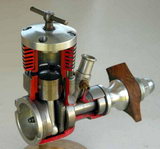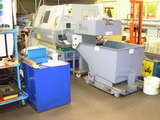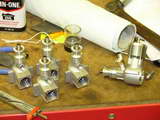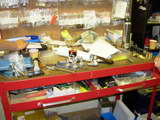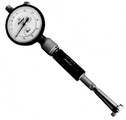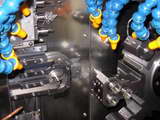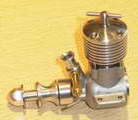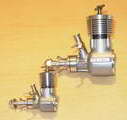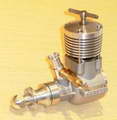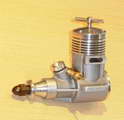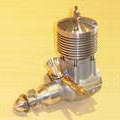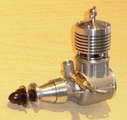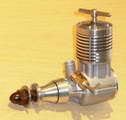Oliver Production
Click on images to view larger picture.
Hover for a description.
Such is the reputation of John Oliver's engines that copies and replicas have been produced worldwide. I suggest you read John Goodall's book, The Olivers and a Tiger, which covers the history of their products. The Oliver Tiger Mk III set the standard in 1958 when Dick Edmond won the Team Race World Championship, Mike Gaster having previously won the Free Flight World Championship in 1955 using an Oliver Tiger Mk II. Fuel consumption was not an important issue for Free Flight, despite the introduction of the power loading rule in 1958. But by 1960, the engine was out performed by higher RPM operation of the glowplug engine. As with all production items, not all Olivers achieved perfection, so a number of individuals set about so called tuning to suit the various applications in which the engines were being used. In principal this involved minor rectification to improve mechanical efficiency, although some changes such as modification of the crankshaft to improve gas flow frequently led to failure. In recent times the Rothwell Replica variant has enabled Vintage Team Racing to continue. The Mk V being developed by Bernie Langworth is an exception and is not an approved vintage engine. An ongoing problem for enthusiasts in the Vintage environment is what is approved. Current performance does not reflect that of the period, so if you allow engines manufactured after the cut-off date, these will almost certainly reflect ongoing development.
In February 2009, the BFMA newsletter announced that Tom Ridley had taken over production of the Oliver range of engines using most of John's original tooling (see the Feb 2009 MEN Issue). Production is now located in central England at Hinckley near Coventry. Although the company applies CNC manufacturing techniques, many of the methods used are those developed by John who continues to provide advice. These are to be sold as actual Olivers, not replica Olivers. Tom continues with the original numbering system hence there is no visual difference in appearance. They will also provide vintage performance.
Substantial sums of money are involved in a project of this kind, so do not expect to obtain engines at far-Eastern pricing. There has always been a problem with users expecting precision items at toy pricing, hence the failure of many UK engine manufacturers. However the full range of engines are on offer at prices substantially less than those that have been paid by engine collectors in recent years.
Having now made several visits to the factory, I am impressed by the quality and effort put into the current production. Every effort is being made to ensure that the engines produced are at least up to original standards. Whilst there is potential for full scale production, the fact that all engines receive individual attention and test will limit the number that can be produced. In a production environment, all operations have to be evaluated to determine which operation limits the production rate. CNC manufacture reduces scrap rates, but it ties up money in component stock which may never be sold. It is therefore difficult to determine what the true cost of components is. Large stocks of components on the shelf or in the stores do not help cash flow. Alan Greenfield has large stocks of ED spares which may never be sold because some essential items are missing. This has been the downfall of ED and other engine manufacturers because you only get paid for what is dispatched to the customer. If you need spares for your current Oliver order them now while stock is available.
So let us review manufacture. Crankcase castings will be produced in LM25 using the original dies. Cases are heat-treated to improve strength and machining properties. The cylinder bolt lugs had been extended down to the crankshaft bore outer diameter, this was a later modification of the gravity dies. All John's original castings have now been machined and new dies have now been made so that the original short style cylinder bolt lug crankcase Tiger Mk III can be produced.
Tom has added a reverse spiral groove to the crankcase crankshaft bore front end to minimise mixture leakage through the front ball bearing. I cannot confirm how effective this might be, my own plain journal bearing Dynamic engines feature a cascade restrictor capillary groove. However in this case it retains lubricant for the crankshaft.
The current crankshaft is made from EN36 steel. It is a known fact that some replica Oliver suffer from crankshaft failures when trying to operate them on 8x4 and 8x3 propellers. In all probability they were made from unsuitable material, or lacked the adequate fillet radii required to prevent premature fatigue failures. EN36 is a 65 ton tensile steel which is difficult to machine to the high standard required in this application. This is further complicated by the heat treatment process. Hence an additional grinding allowance is required to ensure correct hardness and finish on the shaft and crankpin. The current production items do not include gas flow modifications observed on tuned Oliver's circa 1958/9 Mk III (see tuning modifications in John Goodall's book).
Back in the 1960's Hoffman bearings were probably the best available. Currently, sourcing of suitable bearings can be a problem. Few bearings are now marked with the company name and bearing fit. Tom has obtained a supply of far-Eastern bearings with adequate radial clearance. The crankcase assemblies I examined had nicely fitted shafts which spun up freely—it was obvious to me that particular attention had been given to this.
The current cylinder is produced from EN1A, honed to a taper and chrome plated (this was one of the options which gives longer cylinder life). Following plating the cylinder bore is internally polished using a suitable honing stone to remove any high spots which may have occurred during the plating process. Note that the chrome is extremely hard so only the high spots are removed. Readers should appreciate that the cylinder must be round and have the correct taper and surface finish prior to plating. The required piston fit cannot be achieved if this is not so.
To facilitate cylinder production, Tom has obtained a Delapena Bench Honing machine which is identical to my own, however he has modified the honing stone pressure system so that these follow the previously machined taper. In the standard system, the stones are loaded via a wedge which ensures out of roundness errors are eliminated. Tom's stones are spring loaded, so it does not appear possible to correct out of roundness errors which may occur following heat treatment, or prior operations. Operating the standard honing machine requires a high degree of operator skill, hence at ED these bench machines were superseded by improved equipment which included Mercer air gauging to verify size, roundness and taper. Measurement and inspection of the cylinder bore is a crucial factor in cylinder production. At the present Tom has not invested in sophisticated measuring equipment. Personally, I have been using a Mitutoyo Bore Gauge, however this too requires a high level of skill due to variations in surface finish.
I was given the opportunity to take some photographs of the equipment used for production and Tom at work grinding pistons to fit cylinders. Prior to grinding, the cast iron piston is hardened. This process can marginally increase the size and may make fitting the gudgeon pin difficult due to distortion where such items are not symmetrical. No circlips are fitted to retain the gudgeon pin hence this is not fully floating as is the case with modern racing engines. Following grinding, final fit is achieved using a bronze lap and diamond paste, hence grinding and lapping is completed in a single operation. Whilst this is not the method employed by ED, it does suit small scale production.
The engines are fitted with fully machined connecting rods manufactured by CNC. These are made from RR56 alloy bar.
The cooling jacket is a fairly substantial item secured by in-house manufactured cylinder bolts. It has always puzzled me why commercial fixings have not been employed. Clamping the cylinder at exhaust port level has always presented the problem of distortion which has led to the development of the tapered cylinder. There are warnings in the instructions on the tightening of these screws and it is not uncommon to see vintage cases with broken corners. As already stated, the crankcase cylinder bolt bosses have been extended to minimise this problem which is not restricted to Olivers, being common to many engine makes.
All other items are nicely made and do not require comment.
Oliver enthusiasts will have much to thank Tom Ridley for in extending the production period of this most respected mark. Engines in current production are:
- Oliver Cub Mk II 1.5cc and Schnuerle Port Cub 1.5cc
- Oliver Tiger Mk III 2.5cc Long and Short Head Bolt boss lugs.
- Oliver Tiger Mk IV 2.5cc.
- Oliver Tiger Mk V 2.5cc Schnuerle Port.
- Oliver Major MK II 3.5cc.
Please direct all enquiries to [email protected].
This page designed to look best when using anything but IE!
Please submit all questions and comments to
[email protected]
